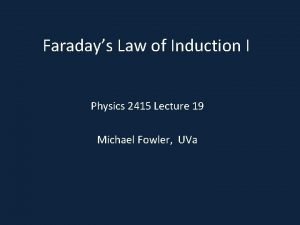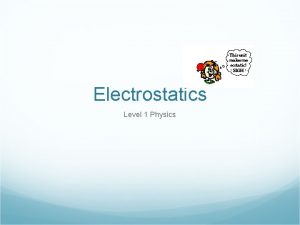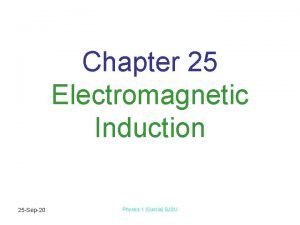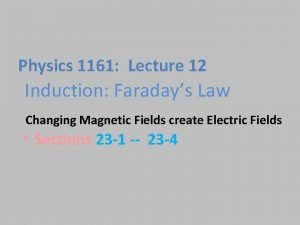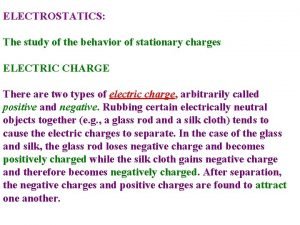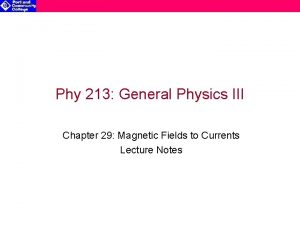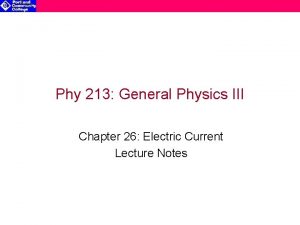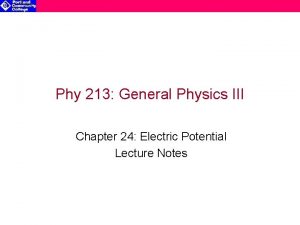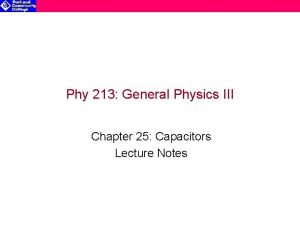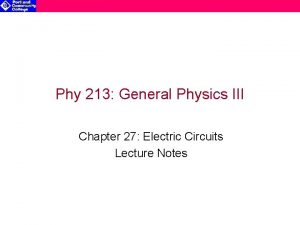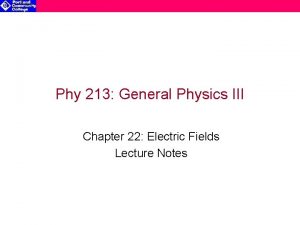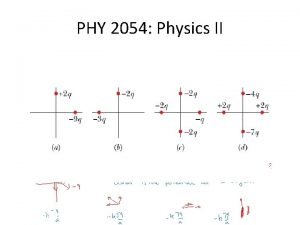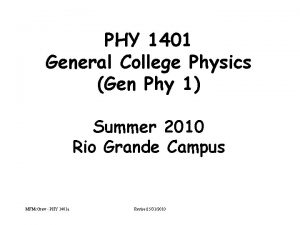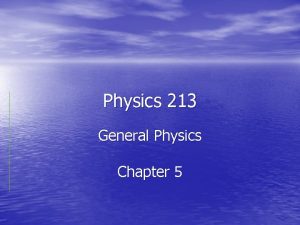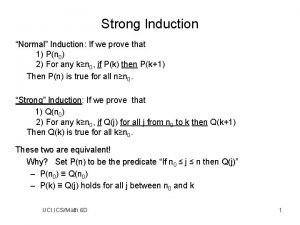Phy 213 General Physics III Chapter 30 Induction













- Slides: 13

Phy 213: General Physics III Chapter 30: Induction & Inductance Lecture Notes

Electromagnetic Induction • We have observed that force is exerted on a charge by either and E field or a B field (when charge is moving): • Consequences of the Lorentz Force: – A B field can exert a force on an electric current (moving charge) – A changing B-field (such as a moving magnet) will exert a magnetic force on a static charge, producing an electric current → this is called electromagnetic induction • Faraday’s contribution to this observation: – 1. 2. 3. • • For a closed loop, a current is induced when: The B-field through the loop changes The area (A) of the loop changes The orientation of B and A changes A current is induced ONLY when any or all of the above are changing The magnitude of the induced current depends on the rate of change of 1 -3 q q N N S S Moving charge Moving magnet

Magnetic Flux • Faraday referred to changes in B field, area and orientation as changes in magnetic flux inside the closed loop • The formal definition of magnetic flux (FB) (analogous to electric flux): f When B is uniform over A, this becomes: • Magnetic flux is a measure of the # of B field lines within a closed area (or in this case a loop or coil of wire) • Changes in B, A and/or f change the magnetic flux Faraday’s Law: changing magnetic flux induces electromotive force (& thus current) in a closed wire loop

Faraday’s Law • When no voltage source is present, current will flow around a closed loop or coil when an electric field is present parallel to the current flow. • Charge flows due to the presence of electromotive force, or emf (e) on charge carriers in the coil. The emf is given by: i • An E-field is induced along a coil when the magnetic flux changes, producing an emf (e). The induced emf is related to: – The number of loops (N) in the coil – The rate at which the magnetic flux is changing inside the loop(s), or Note: magnetic flux changes when either the magnetic field (B), the area (A) or the orientation (cos f) of the loop changes:

Changing Magnetic Field A magnet moves toward a loop of wire (N=10 & A is 0. 02 m 2). During the movement, B changes from is 0. 0 T to 1. 5 T in 3 s (Rloop is 2 W). 1) What is the induced e in the loop? 2) What is the induced current in the loop?

Changing Area A loop of wire (N=10) contracts from 0. 03 m 2 to 0. 01 m 2 in 0. 5 s, where B is 0. 5 T and f is 0 o (Rloop is 1 W). 1) What is the induced e in the loop? 2) What is the induced current in the loop?

Changing Orientation A loop of wire (N=10) rotates from 0 o to 90 o in 1. 5 s, B is 0. 5 T and A is 0. 02 m 2 (Rloop is 2 W). 1) What is the average angular frequency, w? 2) What is the induced e in the loop? 3) What is the induced current in the loop?

Lenz’s Law • When the magnetic flux changes within a loop of wire, the induced current resists the changing flux • The direction of the induced current always produces a magnetic field that resists the change in magnetic flux (blue arrows) Magnetic flux, FB i i Increasing FB • Review the previous examples and determine the direction of the current

Operating a light bulb with motional EMF Consider a rectangular loop placed within a magnetic field, with a moveable rail (Rloop= 2 W). B = 0. 5 T v = 10 m/s L = 1. 0 m Questions: 1) What is the area of the loop? 2) How does the area vary with v? 3) What is the induced e in the loop? 4) What is the induced current in the loop? 5) What is the direction of the current?

Force & Magnetic Induction What about the force applied by the hand to keep the rail moving? • The moving rail induces an electric current and also produces power to drive the current: P = e. i = (5 V)(2. 5 A) = 12. 5 W • The power (rate of work performed) comes from the effort of the hand to push the rail – Since v is constant, the magnetic field exerts a resistive force on the rail: The force of the hand can be determined from the power:

Generators & Alternating Current • Generators are devices that utilize electromagnetic induction to produce electricity • Generators convert mechanical energy into electrical energy – Mechanical energy is utilized to either: • Rotate a magnet inside a wire coil • Rotate a wire coil inside a magnetic field – In both cases, the magnetic flux inside the coil changes producing an induced voltage – As the magnet or coil rotates, it produces an alternating current (AC) {due to the changing orientation of the coil and the magnetic field} • Motors and Generators are equivalent devices – A generator is a motor running in reverse:

Maxwell’s Equations Taken in combination, the electromagnetic equations are referred to as Maxwell’s Equations: 1. Gauss’ Law (E) 2. Gauss’ Law (B) 3. Ampere’s Law 4. Faraday’s Law

Significance of Maxwell’s Equations 1. A time changing E field induces a B field. 2. A time changing B field induces an E field. 3. Together, 1 & 2 explain all electromagnetic behavior (in a classical sense) AND suggest that both E & B propagate as traveling waves, directed perpendicular to each other AND the propagation of the waves, where: and The product, moeo, has special significance: or
 Hamlet act iii scene ii
Hamlet act iii scene ii Paramagnetic
Paramagnetic Induction charging physics
Induction charging physics What is induction in physics
What is induction in physics Whats induction physics
Whats induction physics What is the study of stationary electric charges
What is the study of stationary electric charges Phy 131 past papers
Phy 131 past papers Phy 231 msu
Phy 231 msu Great orthogonality theorem
Great orthogonality theorem Rotational statics
Rotational statics Phy theorem
Phy theorem Phy 113 past questions and answers
Phy 113 past questions and answers Phy 131 asu
Phy 131 asu Ddr phy architecture
Ddr phy architecture

